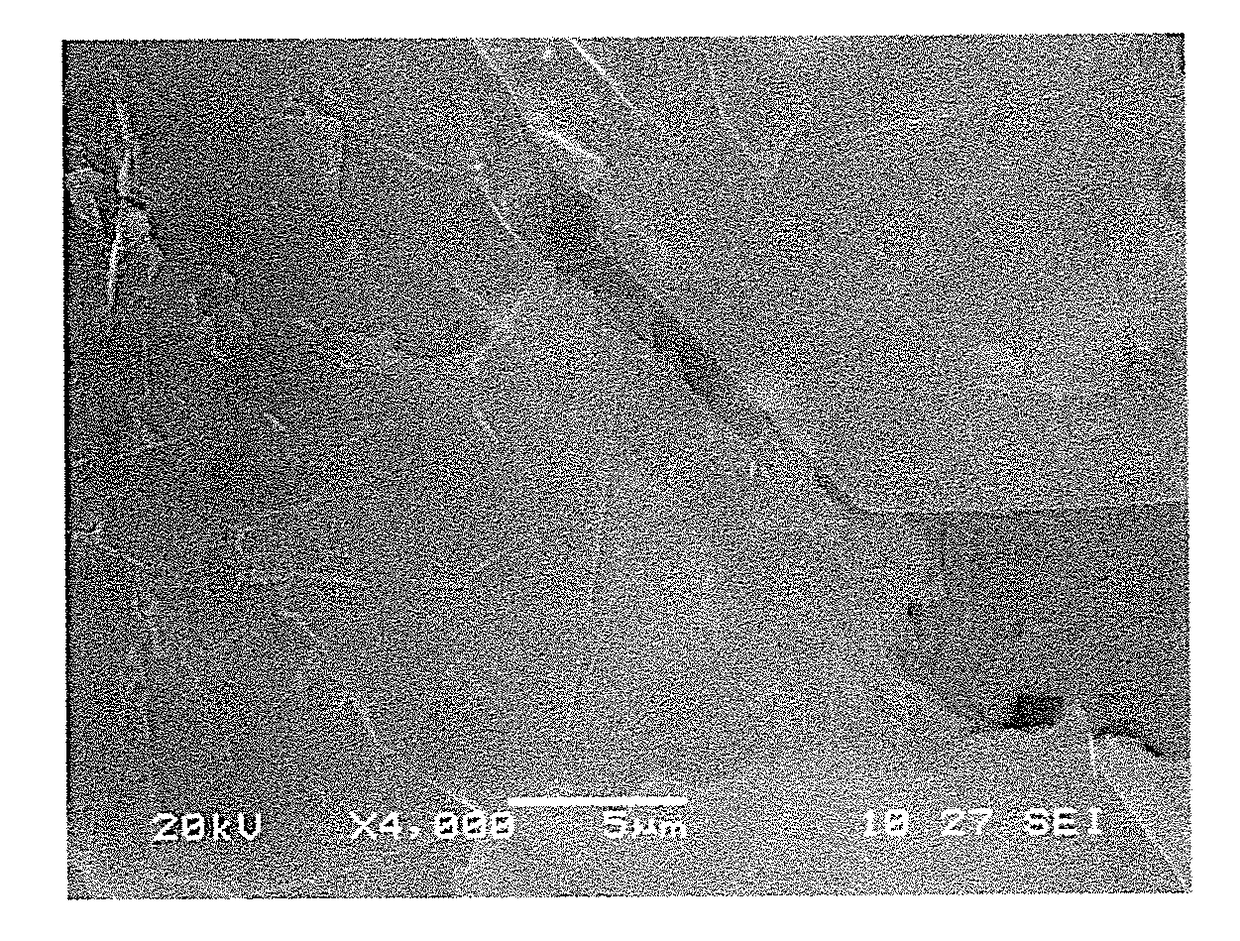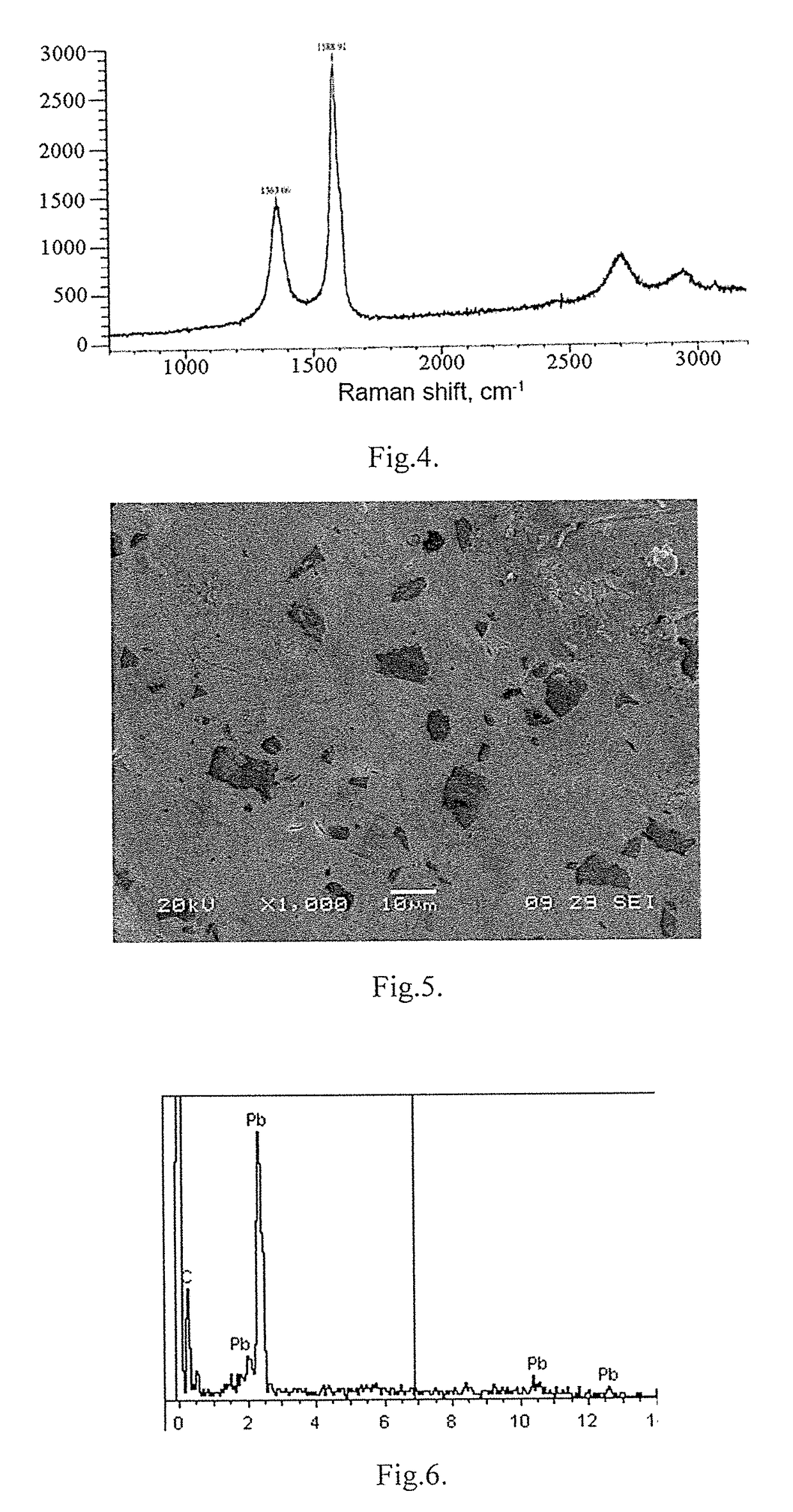Lead-carbon metal composite material for electrodes of lead-acid batteries and method of synthesizing same
a lead-acid battery and metal composite material technology, applied in the field of battery industry, can solve the problems of extremely low solubility of carbon and the creation of lead-carbon metal materials, and achieve the effects of increasing hardness and electrical conductivity of metallic lead-carbon composite materials, and low porosity
- Summary
- Abstract
- Description
- Claims
- Application Information
AI Technical Summary
Benefits of technology
Problems solved by technology
Method used
Image
Examples
example 1
[0041]An alumina crucible was placed in a vertical heating furnace, 40 g of a dry mixture of lithium and potassium chlorides with potassium fluoride containing 15 g of tungsten carbide powder with a particle size of up to 50 μm were placed on its bottom. Over the carbide-containing salt mixture, lead pellets with a diameter of up to 5 mm with a purity of 99.9% by weight were placed onto which 10 g of a finely divided mixture of chlorides and fluorides of lithium and potassium were poured. After that, the furnace was heated to a temperature of 700° C. and held in an air atmosphere for 5 hours. At the same time, the carbide ion passed into the lead melt to form a lead-carbon composite. After high-temperature interaction, the lead-graphene composite was cooled at a rate of less than 0.1 deg / min.
[0042]In the cross-sectional image of the lead-carbon composite material shown in FIG. 1, it can be seen that the carbon formed inside the lead melt forms graphene layers 1 to 3 that are evenly ...
example 2
[0043]An alumina crucible was placed in the vertical heating furnace, 40 g of a dry mixture of chlorides, lithium, sodium, potassium, cesium containing 0.5 g of silicon carbide powder with a particle size of up to 100 μm were placed on its bottom. A disk of high purity lead was placed on top of the carbide-containing salt mixture, to which 10 g of the same finely divided salt mixture was poured, after which the furnace was heated to a temperature of 750° C. and held in an air atmosphere for 2 hours. In this case, the carbide ion passed into an aluminum melt with the formation of a lead-carbon composite. After high-temperature interaction, the lead-graphene composite was rapidly cooled in a water-cooled crucible. The cross-sectional image of the lead-carbon composite is shown in FIG. 5. The EDS spectroscopy data presented in FIG. 6 indicate the production of a lead-carbon composite with a content of 2.55 wt. % of carbon. In FIG. 7 shows the Raman spectrum of the carbon inclusion-grap...
example 3
[0044]An alumina crucible was placed in a vertical heating furnace, 40 g of a dry mixture of sodium, potassium, cesium chloride and ammonium fluoride containing 3.5 g of a tartaric acid powder were placed on its bottom. Over the carbon-containing salt mixture, granules of lead alloy Cl were placed on which 10 g of the same finely divided salt mixture were poured. After that, the furnace was heated to a temperature of 800° C. and held in an air atmosphere for 1 hour. In this case, the carbide ion passed into the lead melt to form a lead-carbon composite. After high-temperature interaction, the lead-graphene composite was cooled together with the furnace. The cross-sectional image of the lead-carbon composite material is shown in FIG. 8. The EDS spectroscopy data presented in FIG. 9 indicate the production of a lead-carbon composite with a content of 1.28 wt. % of carbon. In FIG. 10 shows the Raman spectrum of carbon inclusion—graphene.
[0045]The resulting composites are a typical meta...
PUM
| Property | Measurement | Unit |
|---|---|---|
| temperature | aaaaa | aaaaa |
| particle size | aaaaa | aaaaa |
| pressure | aaaaa | aaaaa |
Abstract
Description
Claims
Application Information
 Login to View More
Login to View More - R&D
- Intellectual Property
- Life Sciences
- Materials
- Tech Scout
- Unparalleled Data Quality
- Higher Quality Content
- 60% Fewer Hallucinations
Browse by: Latest US Patents, China's latest patents, Technical Efficacy Thesaurus, Application Domain, Technology Topic, Popular Technical Reports.
© 2025 PatSnap. All rights reserved.Legal|Privacy policy|Modern Slavery Act Transparency Statement|Sitemap|About US| Contact US: help@patsnap.com



